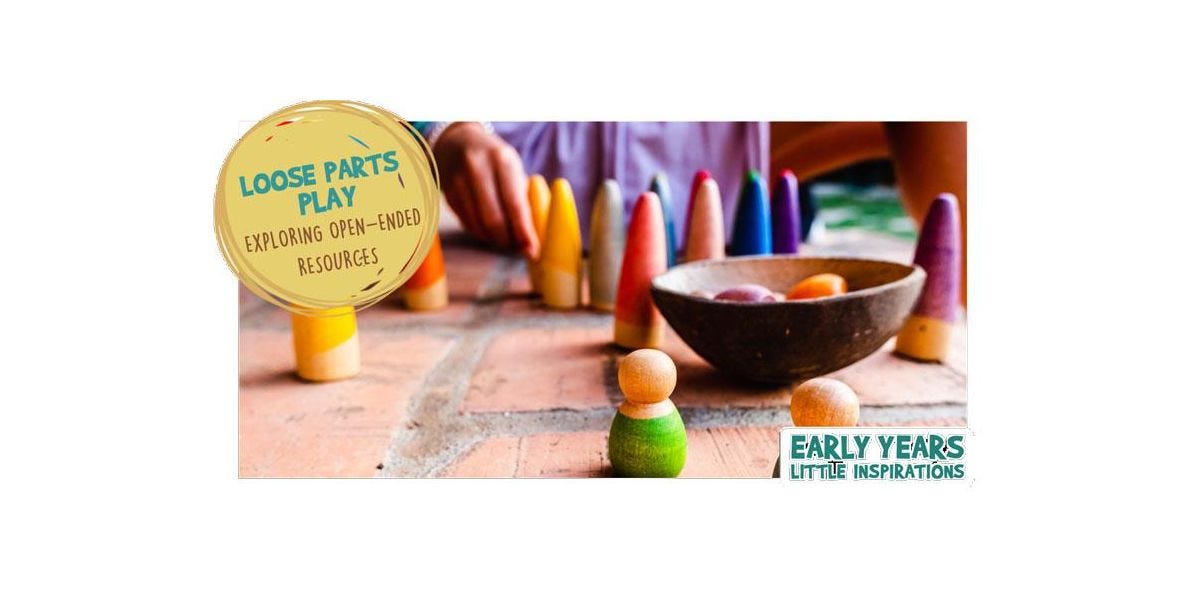Introducing loose parts play into a setting can be a hugely empowering and valuable experience. As practitioners, our role is to facilitate an enabling and inspiring environment for children and incorporating loose parts into our provision can help us to achieve this.
Firstly, it’s important to understand what we mean by ‘loose parts’. They are open-ended resources that can be natural or man-made and come in a variety of shapes and sizes. Here are some examples:
- Sticks
- Leaves
- Pebbles
- Shells
- Cotton reels
- Curtain rings
- Fabric
- Beads
- Buttons
- Pinecones
- Clothes pegs
- Boxes
- Planks
- Tyres
- Cable reels
The value of loose parts lies in them being open to interpretation by children, so they can use them how they choose to. A toy apple in the role play area can only ever be a toy apple whereas a slice of wood can be a range of things. Children can use this as a piece of fruit, a bus ticket, a coin, a walkie talkie, a birthday cake, dog biscuit, doorbell, key or magic bean - the possibilities are endless! Loose parts are also non-gendered, adding to their diverse nature.
There are important things to consider before introducing loose parts to your setting. There needs to be a thorough risk assessment of your resources so you can be sure they are safe, free of broken parts or sharp edges. Risk assessments need to be ongoing and take into account wear and tear and the usual damage that occurs naturally as part of the play. Loose parts also need to be appropriate for the children’s age and stage of development, with considerations such as whether the parts could be a potential choking hazard.
When introducing loose parts into your setting, it is important to have all staff fully on board. Be prepared for some potential hesitation, such as concerns about health and safety or not fully understanding the purpose of loose parts. Leaders and managers need to listen to these concerns, acknowledging that they are valid but also working to alleviate any apprehension.
It’s important for staff to be enthusiastic, excited and inspired by loose parts, as this is what will motivate the children to engage and embrace them in their play. This can be achieved by involving staff in the process of introducing loose parts and asking for their ideas and input so they can feel like their opinion is valued. There are many loose parts training options suitable for varying needs. These include in-house training, online courses and themed books which can be added to the staff development library.
The role of the adult is foremost to observe children engaging with the resources. This is important in helping the team understand how the loose parts are being used, characteristics of effective learning in action, interests that are evolving and which resources are the most popular. From this, an audit can take place which may lead to the purchasing of additional resources to support particular interests. For instance, if pinecones are proving popular, you need to ensure you have a plentiful supply to inspire play but also to avoid conflicts when there aren’t enough to go around.
You may wish to involve families in creating your loose parts provision by sharing a list of resources you require. Also, make friends with your local charity shop who may be kind enough to let you know if your required items have been donated. Creative thinking can help you source large items – contact a garage to ask about tyres, speak to local electrical companies about sourcing cable reels and get in touch with tree surgeons to ask about donations of logs and wood slices.
Following on from the observation process, we gain a deeper understanding of the power loose parts hold. They can facilitate learning and development across the Early Years Foundation Stage (EYFS), from developing communication and language, promoting social skills, practising fine and gross motor skills, inspiring creativity and imagination, encouraging mathematical development and values such as tolerance, perseverance, patience, cooperation and determination. Some children will develop these skills by themselves through independently engaging with the resources provided. Others may need a little nudge through the help of an adult role model who can provide new concepts and help to develop different ideas and perspectives in their play.
Loose parts play can be empowering for children. The resources are open-ended meaning there is no right or wrong way to play. Children are free to express themselves however they wish, helping them to take charge of their play and learning. As we have not prescribed any particular meaning to the resources, children can set their own agenda. They can come up with their own ideas and narratives, importantly developing their sense of self. Just watching children engaging with loose parts is fascinating. We get to see children motivated, enthusiastic, engaged, focused, and fully absorbed in their play experiences.

